Keywords
|
| Array Factor (AF), Directivity, Fractal, Generator, Particle Swarm Optimization(PSO). |
INTRODUCTION
|
| Today, wireless technology has reached a point that has no choice other than using only one compact and multiband antenna to simultaneously answer all the demands of users at different frequencies. Fractal antennas are one of the best solutions for this problem.The term fractal, which means broken or irregular fragments, was originally coined by Mandelbrot [1] to describe a family of complex shapes that possess an inherent self-similarity in their geometrical structure. He showed that many fractals existed in nature and that fractals could accurately model certain phenomena. He introduced new types of fractals to model more complex structures, such as trees or mountains [2]. Since the pioneering work of Mandelbrot and others, a wide variety of applications for fractals has been found in many branches ofscience and engineering. One such area is fractal electrodynamics,in which fractal geometry is combined with electromagnetic theory for the purpose of investigating a new class of radiation, propagation, and scattering problems. One of the most promising areas of fractal electrodynamics research is in its application to antenna theory and design. |
| Traditional approaches to the analysis and design of antenna systems have their foundation in Euclidean geometry. There has been a considerable amount of recent interest, however, in the possibility of developing new types of antennas that employ fractal rather than Euclidean geometric concepts in their design. We refer to this new and rapidly growing field of research as fractal antenna engineering. The general concepts of fractals can be applied to develop various antenna elements and arrays. Applying fractals to antenna elements allows for smaller, antennas that are multiband/broadband and may be optimized for gain. Applying fractals to antenna arrays develops multiband/broadband arrays. The fact that most fractals have infinite complexity and detail can be used to reduce antenna size and develop low profile antennas. When antenna elements or arrays are designed with the concept of selfsimilarity for most fractals, they can achieve multiple frequency bands because different parts of the antenna are similar to each other at different scales. Application of the fractional dimension of fractal structure leads to the gain optimization of wire antennas. The combination of the infinite complexity and detail and the self-similarity makes it possible to design antennas with very wideband performance [2]. |
| A rich class of fractal arrays exists that can be formed recursively through the repetitive application of a generating subarray. A generating subarray is a small array at scale one (P=1) used to construct larger arrays at higher scales (P>1). A set formula for copying, scaling, and translation of the generating subarray is then followed in order to produce the fractal array. Hence, fractal arrays that are created in this manner will be composed of a sequence of selfsimilar subarrays. In other words, they may be conveniently thought of as arrays of arrays. |
| The array factor for a fractal array of this type may be expressed in the general form |
 |
| where GA(? ) represents the array factor associated with the generating subarray. The parameter? is a scale or expansion factor that governs how large the array grows with each recursive application of the generating subarray. The expression for the fractal array factor given in (1) is simply the product of scaled versions of a generating subarray factor. Therefore, we may regard (1) as representing a formal statement of the pattern multiplication theoremfor fractal arrays. |
| A design methodology for the mathematical construction of fractal arrays which is very general, and consequently provides much more flexibility in the design, when compared to other approaches, is primarily based on the generator that uses a concentric circular ring array. |
| The generating array factor (AF) for the concentric circular ring array may be expressed in the form |
 |
| where |
 |
| 1. k= 2 π/λ = wavenumber |
| 2. M =total number of concentric rings |
| 3. Nm = total number of elements on the mth ring |
| 4. rm = radius of the mth ring |
| 5. I mn = excitation current amplitude of the nth element on the mth ring located at φ= φmn |
| 6. α mn = excitation current phase of the nth element on the mth ring located at φ= φmn |
| The fractal array factor for a particular stage of growth P may be derived directly from (1) by following a procedure similar to that outlined before. The resulting expression for the array factor was found to be |
 |
| Awide variety of interesting as well as practical fractal array designs may be constructed using a generating subarray of the form given in (2). |
| Consider the simple 4-element circular array of radius r shown in Fig. 1a. If we regard this as the generator (stage 1) for a fractal array, then the next stage of growth (stage 2) for the array would have a geometrical configuration of the form shown in Fig. 1b. This is followed by replacing each of the elements of the expanded array by an exact copy of the original unscaled 4-element circular subarray generator. The entire process is then repeated in a recursive fashion, until the desired stage of growth for the fractal array is reached. |
| In the fig 1, it shows the subarray generator and the resulting fractal array that is obtained after one iteration. The main goal is to find the best r (Fig. 1), so that the directivity of the array would be maximum. Among the available Optimization algorithms, Particle Swarm Optimization (PSO) algorithm was chosen because of its simplicity, speed, and accepted accuracy. |
MATERIALS AND METHODS
|
| The first step is to create the array structure in CST MICROWAVE STUDIO with 3 to see if it can work in multiband or not. The array is composed of 16 half-wave dipoles at frequency of 2.45 GHz . After the full-wave simulation is done, we can also observe its radiation pattern and other different results.Next, we write the PSO optimization algorithm in MATLAB and initialize it with 50 particles and maximum number of iterations is selected to be 100. The range of variable r is also set to be centered at 0.25 . Then for each particle in each iteration, the array factor and directivity of the array can be calculated using the given formulas in [3]. From the obtained data, PSO will try to find the optimized value for the radius of circles |
RESULTS
|
| As it can be seen from the full-wave analysis results in Fig. 2, the design works in two bands of frequencies with good bandwidths. |
| In the fig 2, it shows the array's input reflection coefficient S11 vs. frequency band of simulation. It is interesting to observe that the second resonance frequency is nearly 3 times the first resonance frequency; which was predicted by (1).Another important result is that calculated directivities for both analytic formulas (MATLAB codes) and fullwave analysis (CST STUDIO SUITE results) are well matched, as shown inFig. 3.In the fig 3, it shows that the theoretical formulas for expressing the array factor of fractal structures are well-defined, so that the directivity of the fractal array which is calculated from the theoretical formula is well-matched with the result from full-wave simulations. Also it can be seen from Fig. 4 and Fig. 5 that the PSO algorithm has successfully converged and all the particles have moved toward the best position r , and this is the radius for which the directivity of the array is maximum in the domain that we defined for r to change.. |
| In the fig 4, it shows the initial position that was set to be r=0.25λ in comparison with the best position that all particles moved towards. |
| In the fig 5, it shows how particle #1 (for example) has moved towards the best position over 100 iterations of PSO algorithm. Also it shows that as the particles move towards the best position, their speed graduallyreduces until it becomes zero which means they have reached the desired destination. |
| The last result is completely matched with Fig. 6, which is obtained from different CST simulations. |
| In the fig 6, it shows the maximum directivity of the simulated array structure for different values of r. |
CONCLUSION
|
| In this work, we used a circular subarray generator to produce a fractal antenna array, so that it can work in two frequencies, which is nearly impossible for classic arrays to achieve. Then, PSO optimization algorithm was successfully used to optimize the radius of circles to obtain the maximum directivity from the design. |
ACKNOWLEDGMENT
|
| The authors would wish to thank Dr. H. Abiri and all who are associated with “Fast Computations Center” of Shiraz University for their great support of this work. |
Figures at a glance
|
 |
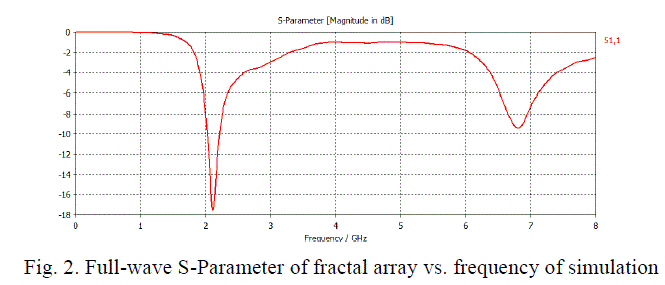 |
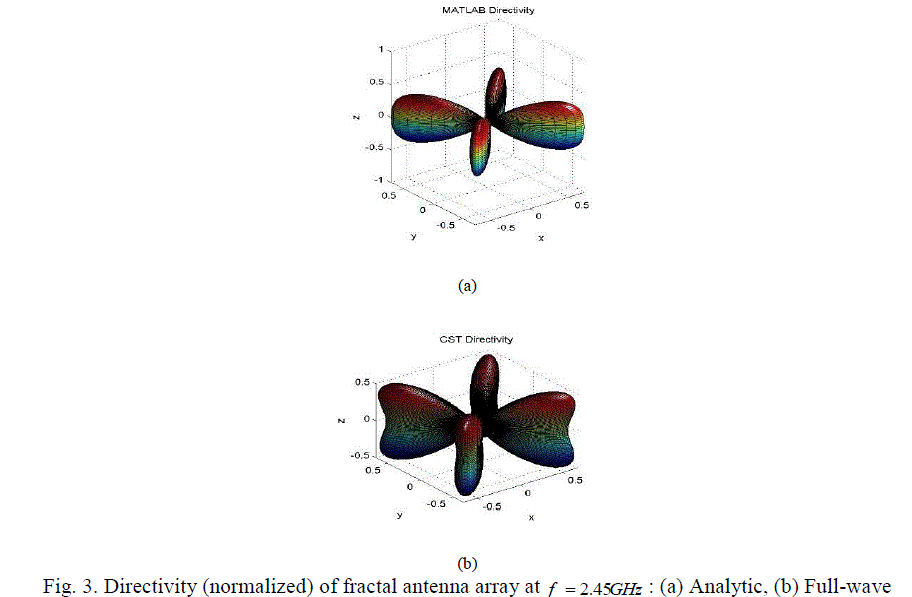 |
| Figure 1 |
Figure 2 |
Figure 3 |
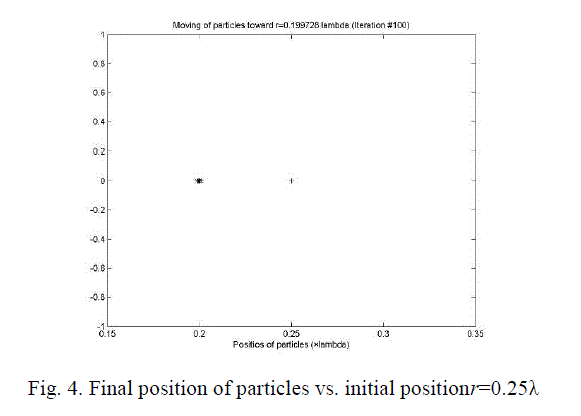 |
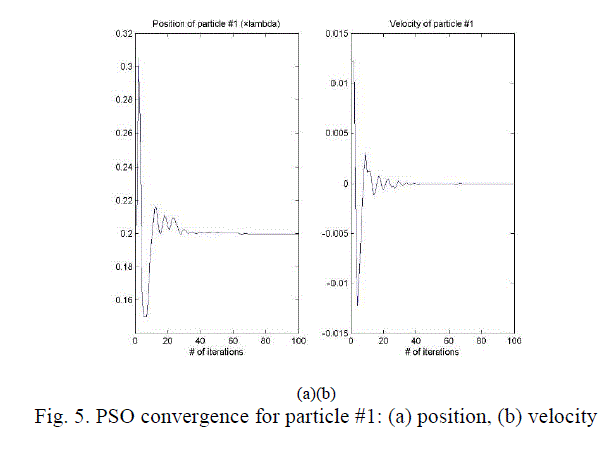 |
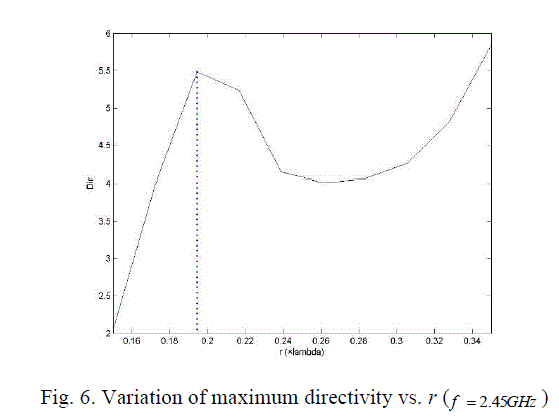 |
| Figure 4 |
Figure 5 |
Figure 6 |
|
| |
References
|
- B. B. Mandelbrot, The Fractal Geometry of Nature, New York, W. H. Freeman, 1983.
- Douglas H. Werner, Randy L. Haupt, and Pingjuan L. Werner, “Fractal Antenna Engineering: The Theory and Design of Fractal Antenna Arrays”, IEEE Antenna and Propagation Magazine, Vol. 41, No. 5, pp. 37-58, 1999.
- Constantine A. Balanis, Antenna Theory,John Wiley & Sons, Inc., 3rd edition, 2005, ch 2.
|